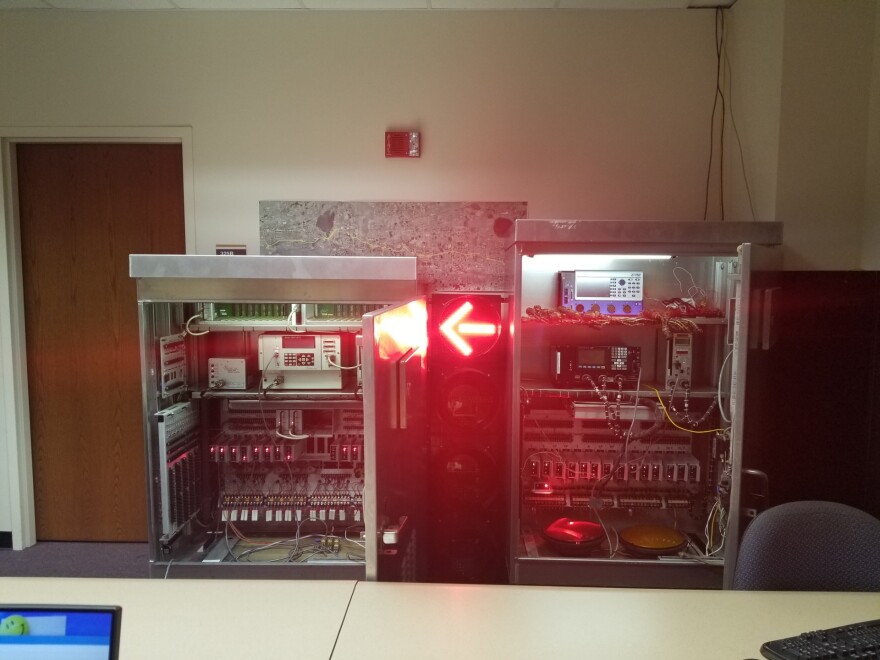As populations change, traffic lights need to adapt
So, here’s a question, have you ever been stopped by a traffic signal in the Orlando area that was so long you began to look around in amazement wondering what was actually going on? If so, you’re not the only one.
MetroPlan Orlando said it gets lots of calls about stoplights being too long and questions about whether they’re actually getting longer. MetroPlan is the transportation planning authority for Orange, Osceola and Seminole counties and Eric Hill is the Director of Transportation Systems.
The organization recently wrapped up a request for proposals for a company to look at traffic signal timing. It’s something Hill said they’ve been doing for a while now.
“Until we started it, traffic signals were normally retimed when there were complaints,” Eric Hill said. “We saw the traffic signal retiming program as a way for us to be proactive and to start a program where we're trying to adjust our infrastructure and our operations to meet the demands of our traveling public,” Hill said.
While Hill acknowledged that a traffic light might feel like it takes five minutes and is frustrating, he said perception is playing a larger role here than the lights themselves.
“Everyone wants a traffic light to accommodate them, and it just doesn't work that way,” Hill said. “There are several other motorists that want to get through an intersection just like you, or they want to make a turn at an intersection just like you, so we can't meet everyone's demand.”
In addition to perception, Hill said the roadways are not just for drivers, but for everyone. He said MetroPlan Orlando doesn’t always improve travel time or work to increase traffic speed because of pedestrians or cyclists.
Do you feel like you are sitting at a red light forever?
Hill said traffic lights are all on a timing sequence. While some roadways can have lights that turn red to green in 60 seconds, others can take about three minutes. Those longer waiting periods can be found on busier streets, for example, on Alafaya or East Colonial in Orlando.
“While you do have longer green times on the arterial roadways during the peak hours of the day, I just want to add that technology has also helped us improve what we're doing,” Hill said. “We now have the technology that can adjust our traffic signal timing on the fly, if you will.”
That technology can help adjust the timing of intersections if, for example, there is a major crash disrupting the flow of traffic.
However, Hill explained that MetroPlan Orlando doesn’t just retime a light and leave it. He said adjusting traffic lights or intersections is a lengthy process.
In addition to the work the organization does on retiming, Hill said “we also do a before and after study, so we don't just go ahead and make the investment and walk away from it. We also do an evaluation to see if it has improved our travel time, our reliability, and, in some instances, safety.”
Distracted while driving? You could be causing traffic
Hatem Abou-Senna is an associate professor at the University of Central Florida, who specializes in traffic and transportation engineering. Similar to Hill, Abou-Senna said human nature can play a large role in transportation and traffic. However, he specifically stated that distracted drivers could be helping to cause that congestion.
Abou-Senna said things like playing music on your phone or texting can impact the timing of how many cars actually make it through an intersection.
“I think you shouldn't be using your phone while the vehicle is moving, but you can use it while the vehicle is stationary,” Abou-Senna said. “Most of the time people will be using it during the red light, so when the signal turns green it's not just the startup loss time with the regular waiting.”
Abou-Senna worked with the Florida Department of Transportation, or FDOT, on a study looking at distracted drivers. People on their phones, for example, can make traffic longer for everyone else on the road because they may not notice when a light turns green holding up everyone else.

“What we found from this research is that the startup loss time is almost doubled from two seconds now to four seconds, which reduces the capacity of an intersection by 45 to 50%,” Abou-Senna said. “The phone, the dashboard, the entertainment systems in the vehicles, all of that affects the operations at the intersection.”
In other words, an intersection where six vehicles should have been able to turn left could end up with only three actually making it through the light.
As mentioned earlier, Abou-Senna said if a road is more popular, like on four or six lane roads, traffic lights during peak hours of congestion could take around three minutes to turn from red to green. He said longer times on major roadways helps with traffic flow at one intersection, but because everything is about timing, intersections along that roadway.
In addition to the work MetroPlan Orlando does in the region Abou-Senna said organizations, municipalities and the state are constantly looking for ways to improve technology and transportation systems.
For example, the flashing yellow light for left turns, is something Abou-Senna worked on. He said it helps move traffic along faster.





